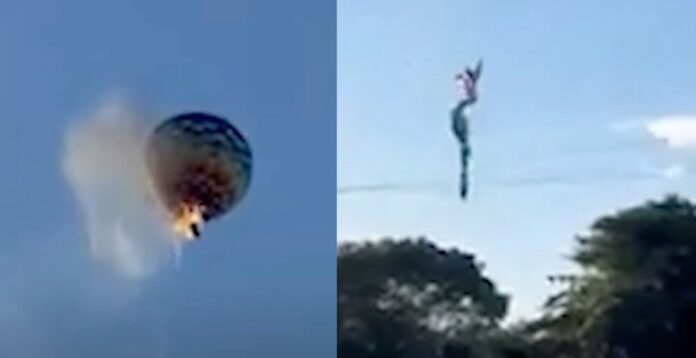- Deadly Crash in Brazil: A hot-air balloon caught fire midair and crashed in Praia Grande, killing at least 8 people and injuring several others.
- Conflicting Reports: Authorities confirmed 21 people onboard, with 13 survivors, but details on fatalities and rescue efforts remain unclear.
- Public Outrage and Safety Concerns: The tragedy, following another balloon death days earlier, has sparked national concern over ballooning safety and regulation.
A hot-air balloon ride meant to be a dreamlike adventure turned into a terrifying ordeal on Saturday morning in southern Brazil, as flames engulfed the aircraft midair, sending it plummeting to the ground. At least eight people have been confirmed dead in what has now become one of the worst ballooning tragedies in the country’s recent memory.
The incident unfolded in the scenic region of Praia Grande, located in the southern state of Santa Catarina. Known as Brazil’s answer to Cappadocia—a picturesque hotspot famous for its colorful skies filled with drifting balloons—the area is now marked by smoke, grief, and a growing list of questions.
From Floating Wonder to Fiery Nightmare
Witnesses who gathered to watch the morning’s balloon flights were left frozen in horror as one of the aircrafts suddenly erupted into flames. A video that quickly circulated on social media captured the shocking moment: a giant plume of fire surging from the burner, black smoke billowing upward, and then—without warning—the balloon began to collapse.
The envelope deflated in seconds. Flames spread rapidly down the fabric, setting the basket ablaze. Screams echoed as the basket detached midair and hurtled toward the ground, trailing smoke and fire behind it. Moments later, the balloon crashed into a densely wooded area. A loud thud followed by chilling silence confirmed the worst fears.
Emergency responders rushed to the crash site, navigating rugged terrain and heavy vegetation. The scene they encountered was harrowing. Charred wreckage lay scattered across the forest floor. The heat from the flames had scorched nearby trees. Survivors, dazed and injured, were being pulled from the ruins.
Conflicting Reports Add to the Chaos
Official updates have been trickling in, but discrepancies remain. The governor of Santa Catarina, Jorginho Mello, initially posted on X (formerly Twitter) announcing eight deaths out of 21 people aboard. That message was later deleted as new information emerged.
In his most recent update, Mello confirmed the same number of fatalities but expressed hope, stating that 13 people had somehow survived the horrific fall. “Our teams continue to provide support to the victims and their families. We are monitoring everything closely,” he added.
However, the Santa Catarina Military Fire Department released a slightly different version of events. “Four deaths have been confirmed at the scene,” the department said. “Rescue teams are continuing to search and evaluate those involved.”
This inconsistency has caused confusion among local residents and families anxiously waiting for news. For some, the lack of clarity is making an already tragic situation even more unbearable.
Survivors Pulled From the Wreckage
Against all odds, 13 people reportedly survived the plunge. Authorities have not yet released names, but some of the survivors were taken to nearby hospitals with burns, fractures, and shock.
“It’s a miracle anyone made it,” said firefighter Luiz Machado, one of the first responders on the scene. “The way it fell, the speed, the fire—there should have been no survivors.”
Relatives of the victims gathered at local hospitals and police stations, desperate for answers. Some wept in each other’s arms. Others paced anxiously, glued to their phones, clinging to any shred of hope.
A Second Tragedy in One Week
Saturday’s disaster marks the second deadly hot-air balloon incident in Brazil in less than a week. Just days earlier, Juliana Alves Prado Pereira, a 27-year-old psychologist, died during a balloon flight in São Paulo.
Juliana had been celebrating a romantic getaway with her husband, Leandro de Aquino Pereira, when tragedy struck. That balloon also carried over 30 people, with 11 injured in the aftermath. Her death had already sparked growing concerns over ballooning safety in the country—and now those concerns have exploded into national outrage.
A Growing Outcry: “This Was Preventable”
In the wake of these twin tragedies, questions are mounting. How could two fatal accidents happen within days? Were safety protocols ignored? Was overcrowding a factor?
Locals and tourists alike are demanding accountability. On social media, the reaction has been fierce. “This was preventable,” wrote one user under Governor Mello’s post. “Two accidents in a week? Something is seriously wrong with these companies.”
Another user pointed fingers at authorities: “Where is the regulation? Where are the inspections? These companies are risking lives for profit.”
Some balloon tour operators have rushed to defend the industry, insisting that their flights are safe and that the incidents are anomalies. But public trust is rapidly eroding.
Brazil’s Ballooning Boom—Now in Crisis
Hot-air ballooning has become increasingly popular in Brazil over the past decade, especially in scenic regions like Praia Grande. Tour companies offer sunrise rides over the lush landscape, attracting thousands of thrill-seekers and honeymooners each year.
But as the industry booms, so do concerns about overcrowding and oversight. Reports have surfaced of balloon baskets carrying more passengers than permitted and companies operating with outdated equipment.
“The rush to make money has overtaken common sense,” said aviation expert Carlos Eduardo Mena. “Without stricter controls, tragedies like this will continue to happen.”
The Road Ahead: Demands for Change
As Brazil grapples with the aftermath, investigations are underway to determine the exact cause of Saturday’s fiery crash. Authorities are examining weather conditions, mechanical failure, and human error.
In the meantime, the governor has promised a full review of ballooning licenses and safety regulations in the state. National aviation authorities are also expected to step in.




